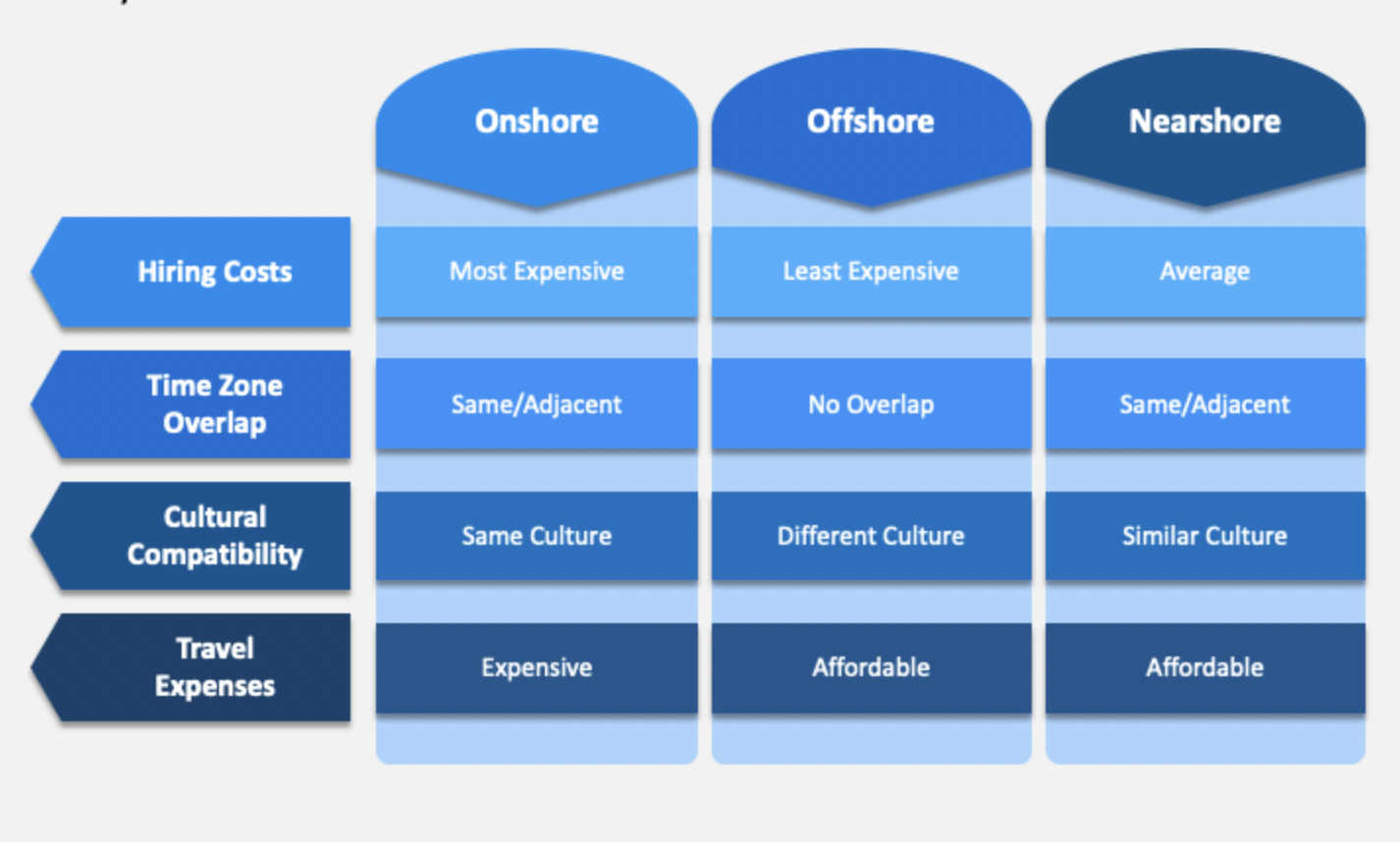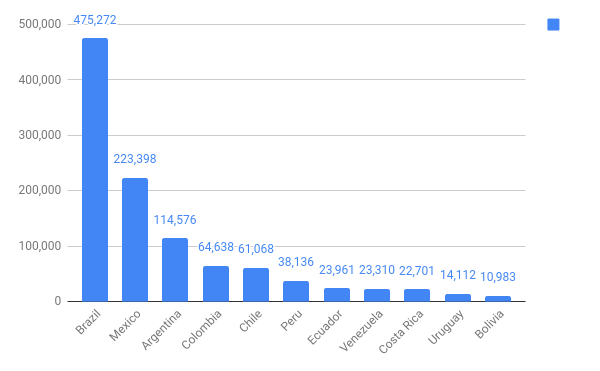The 2020 pandemic caused unprecedented disruption in global supply chains. In 2022, Russia’s invasion of Ukraine added more uncertainty and delays. In the meantime, cybercrime is on the rise and governments are responding by tightening privacy and data protection laws. Recession rumblings driving companies to look for cost-cutting measures. For these and other reasons, companies are turning to nearshoring software development.
Nearshoring can be a workable compromise to bring projects closer to home and still save on software development costs. Click To TweetBloomberg reported in mid-2022 that 80% of US companies are considering nearshoring. No matter if a business makes widgets or sells services, companies are rethinking their onshore and outsourcing strategies. Nearshoring can be a workable compromise to bring projects closer to home and still save on software development costs.
How Nearshoring is Different from Outsourcing and Team Augmentation?
Nearshoring, outsourcing, and team augmentation are different ways of adding resources and expertise to a project. There are some critical differences between them.
Outsourcing refers to contracting out business functions or services to a third-party provider, typically located in a different country, to reduce costs or gain access to specialized expertise.
Team augmentation involves hiring additional staff, either locally or remotely, to supplement an existing team and provide additional skills and expertise. For example, a software development company might hire additional developers contractually to help complete a specific project.

Nearshoring is a type of outsourcing. The difference is the location. Nearshoring outsources business functions or services to a country in the same geographic region. Companies can access a less expensive pool of skilled labor while maintaining similar time zones, cultural similarities, and geographic proximity.
Pros and Cons of Nearshoring Software Development
Deloitte cited cybersecurity and data analytics as top areas in demand for software development outsourcing in 2022-23. With increasing data privacy and cybercrime concerns, nearshoring has started to look less risky to some firms than outsourcing across the planet, especially in Russia or China. Below are some general pros and cons.
Pros for Nearshoring Software Development
- Cost savings - Deloitte says 87% of IT businesses considered nearshore outsourcing to cut costs, and 59% of companies choose nearshoring as a cost-cutting tool. The average hourly rate for nearshore software development is 46% lower than onshore rates.
- Similar time zones and cultural similarities
- Access to a broader pool of skilled labor
- Reduced travel costs.
Cons for Nearshoring Software Development
- Language barriers
- Different legal and regulatory systems
- Different work cultures and holiday schedules
Every project is different and the specific parameters will determine if nearshoring is a fit and if so, what country might be best. Let’s look at an overview of nearshoring options in the Western Hemisphere.
Western Hemisphere Nearshoring Software Development Options
The US has an estimated 4.4 M software developers. In Latin America, Brazil leads the region in the number of developers, followed by Mexico and Argentina.
Number of Software Developers in LATAM countries, 2018

Below is a quick look at a few nearshoring countries.
Brazil
Brazil has the most software developers in LATAM, estimated at 400,000. Sometimes referred to as the India of the Western Hemisphere, Brazil is a popular nearshoring destination due to its large pool of skilled developers and growing tech industry. Brazil has several tech hubs, such as Sao Paulo and Rio de Janeiro.
Mexico
Mexico is a popular nearshoring destination due to its proximity to the US, cultural fit, and large pool of skilled developers. Mexico has a growing tech industry and is home to several tech hubs, such as Mexico City, Guadalajara, and Monterrey.
Argentina
With over 100,000 software engineers, Argentina has a large software developer community (surpassed only by Brazil and Mexico). While the national economy has struggled over the years, unemployment fell in 2022 and analysts expect the economy to continue recovering.
Costa Rica
Costa Rica is a popular nearshoring destination due to its stable political environment and its skilled workforce. A tiny country with a stable political and economic climate, Costa Rica is home to several tech hubs, such as San Jose and Heredia, and has a growing tech industry.
Colombia
Colombia is a growing nearshoring destination due to its skilled workforce, favorable business environment, and growing tech industry. Colombia is home to several tech hubs, such as Bogota and Medellin, and has a growing pool of skilled developers.
Don't Forget the Northern Neighbor - Canada
While labor rates are not as low in Canada as in LATAM, they are still below the US average. Canada is ideal for projects and teams requiring a highly stable political environment and close language and cultural fit. Canada also attracts highly skilled immigrants, has a large pool of competent developers, and is home to several tech hubs.
Choosing a Nearshoring Partner
Choosing a nearshoring software development partner is a critical decision that can significantly impact a project's success. Here are some factors to consider when selecting a nearshoring partner:
- Expertise and skills: Look for a nearshoring partner with experience in the specific technology stack, programming language, or domain that your project requires. Check their track record and client references to ensure they have the expertise and skills to deliver high-quality software development services.
- Communication and Collaboration: Excellent English language skills are generally a must. Look for a responsive nearshoring partner with a transparent communication process.
- Cultural Fit: Choose a partner that shares your values and work ethic and has a similar business culture. Ensure they understand your business goals and objectives and can align with your vision.
- Security and Confidentiality: Ensure that your nearshoring partner has robust security measures to protect your intellectual property and confidential information. Verify that they comply with industry standards and have a strict data protection policy.
- Cost and ROI: Evaluate the cost savings and the potential ROI of working with a partner in a specific location. Compare them with the costs of working with a partner in other locations or developing in-house software.
- Location: Look for a location that has a stable political and economic environment, a good pool of skilled developers, and a favorable business climate.
Moving Ahead
While technology enables businesses to seamlessly collaborate across borders, geopolitical unrest, and economic uncertainty are causing companies to consider bringing their software development projects closer to home.
Are you in the process of beginning or revising your outsourcing plan? At Sharkbyte, we have experience with all aspects of planning outsourcing, nearshoring, and team augmentation. In fact, we specialize in local or nearshoring placements with vetted talent. Contact us today to talk about your nearshoring strategy.
Checklist: Choosing a Nearshoring Software Development Partner
- Cost savings and ROI
- Similar time zones
- Cultural fit
- Access to a broad pool of skilled labor
- Reduced travel costs
- No language barrier issues
- Compatible legal and regulatory systems
- Similar work cultures and holiday schedules
- Expertise and skills
- Communication and collaboration
- Security and confidentiality
- Location stability



